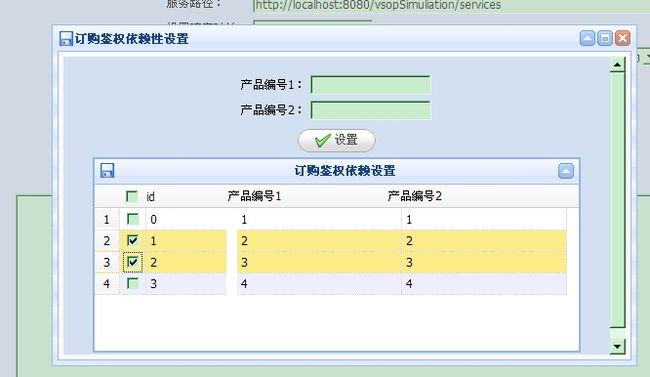好,静态的页面已经可以完成了,下面就开始加上后台的处理部分。
查看easyui的API可以看到,如果需要后台支持的话,需要设置url属性,下面用java来做后台处理数据。
传输的格式用的是JSON,如果你还不知道JSON那么就去baidu一下好了。
后台现在只添加了struts和spring的支持,如果需要连接数据库那么添加上hibernate或者用jdbc等数据处理层的框架好了
好新建jsp页面,添加默认的编码格式为UTF-8
<%
@ page language
=
"
java
"
contentType
=
"
text/html; charset=UTF-8
"
pageEncoding
=
"
UTF-8
"
%>
<%
@ taglib uri
=
"
http://struts.apache.org/tags-bean
"
prefix
=
"
bean
"
%>
<%
@ taglib uri
=
"
http://struts.apache.org/tags-html
"
prefix
=
"
html
"
%>
<%
@ taglib uri
=
"
http://struts.apache.org/tags-logic
"
prefix
=
"
logic
"
%>
设置默认路径
<%
String path
=
request.getContextPath();
String basePath
=
request.getScheme()
+
"
://
"
+
request.getServerName()
+
"
:
"
+
request.getServerPort()
+
path
+
"
/
"
;
request.setAttribute(
"
basepath
"
,basePath);
%>
添加默认的css和必须的js包
<
link rel
=
"
stylesheet
"
type
=
"
text/css
"
href
=
"
${basepath}resources/default.css
"
/>
<
link rel
=
"
stylesheet
"
type
=
"
text/css
"
href
=
"
${basepath}resources/themes/default/easyui.css
"
/>
<
link rel
=
"
stylesheet
"
type
=
"
text/css
"
href
=
"
${basepath}resources/themes/icon.css
"
>
<
script type
=
"
text/javascript
"
src
=
"
${basepath}resources/jquery-1.4.2.min.js
"
>
script
>
<
script type
=
"
text/javascript
"
src
=
"
${basepath}resources/jquery.easyui.min.js
"
>
script
>
<
script type
=
"
text/javascript
"
src
=
"
${basepath}resources/jquery[1].json-1.3.min.js
"
>
script
>
OK,现在可以开始写生成表格的程序了。
在$(function(){}中添加调用表格的程序
$(
'
#tt
'
).datagrid({
title:
'
订购鉴权依赖设置
'
,
iconCls:
'
icon-save
'
,
width:
500
,
height:
200
,
nowrap:
false
,
striped:
true
,
collapsible:
true
,
url:
'
${basepath}simulation/simulation.do?method=yilai
'
,
remoteSort:
false
,
idField:
'
id
'
,
frozenColumns:[[
{field:
'
ck
'
,checkbox:
true
},
{title:
'
id
'
,field:
'
id
'
,width:
80
}
]],
columns:[
[
{title:
'
产品编号1
'
,field:
'
key
'
,width:
160
},
{title:
'
产品编号2
'
,field:
'
value
'
,width:
160
}
]
],
rownumbers:
true
//
toolbar:[{
//
id:'btncut',
//
text:'删除',
//
iconCls:'icon-cut',
//
handler:function(){
//
alert('del')
//
}
//
}]
});
});
要注意生成的数据的格式,是标准的JSON的格式。
将struts所使用的action配置到struts-config.xml中
在Action中调用的方法的内容如下:
/**
* 依赖性设置
*
*
@param
map
*
@param
form
*
@param
req
*
@param
res
*
@return
*
@throws
Exception
*/
public
ActionForward huchi(ActionMapping map, ActionForm form,
HttpServletRequest req, HttpServletResponse res)
throws
Exception {
List
<
PropertyBean
>
l
=
simulationBO.propForGrid(
"
huchi
"
);
JSONArray jsonArray
=
JSONArray.fromObject(l);
String baseStr
=
"
{\
"
total\
"
:1,\
"
rows\
"
:
"
+
jsonArray.toString()
+
"
}
"
;
outJsonUTFString(res, baseStr);
return
null
;
}
注意返回的值的内容,编码格式为UTF-8,看一下outJsonUTFString方法
/**
* dengwei add JSON数据输出
*
*
@param
response
*
@param
json
*/
private
void
outJsonUTFString(HttpServletResponse response, String json) {
//
response.setContentType("text/javascript;charset=UTF-8");
response.setContentType(
"
text/html;charset=UTF-8
"
);
try
{
outString(response, json);
}
catch
(Exception e) {
//
TODO Auto-generated catch block
e.printStackTrace();
}
}
使用response的输出返回给调用的页面
//
输出json格式数据
private
void
outString(HttpServletResponse response, String str) {
try
{
PrintWriter out
=
response.getWriter();
//
out.write(str);
out.println(str);
out.flush();
out.close();
}
catch
(IOException e) {
e.printStackTrace();
}
}
其中使用net.sf.json.JSONArray来处理生成的json对象,将list中的内容格式化成页面上需要返回的json格式,当然也可以使用其它的工具类来完成。
下面把完整的jsp页面和要使用的几个类文件的源码贴上来吧
<%@ page language="java" contentType="text/html; charset=UTF-8" pageEncoding="UTF-8"%>
<%@ taglib uri="http://struts.apache.org/tags-bean" prefix="bean" %>
<%@ taglib uri="http://struts.apache.org/tags-html" prefix="html" %>
<%@ taglib uri="http://struts.apache.org/tags-logic" prefix="logic" %>
<%
String path = request.getContextPath();
String basePath = request.getScheme()+"://"+request.getServerName()+":"+request.getServerPort()+path+"/";
request.setAttribute("basepath",basePath);
%>
依赖设置
产品编号1:
产品编号2:
要使用的struts文件就自己配置一下吧
接下来是Action中的代码可以在上边找一下
然后是逻辑类中的代码文件
public ListpropForGrid(String type){ List l = new ArrayList (); String value = ""; if("yilai".equals(type)){ value = ConfigParser.get("yilai_list"); }else{ value = ConfigParser.get("huchi_list"); } if(value.length()>0){ String[] str = value.split(";"); for (int i = 0; i < str.length; i++) { String[] kvStr = str[i].split(","); PropertyBean prob = new PropertyBean(); prob.setId(i); prob.setKey(kvStr[0]); prob.setValue(kvStr[1]); l.add(prob); } } return l; }
好了,看一下运行的效果吧,这个工程中没有加上分页,因为数据量不大。
如果有需要源码的我可以把源码分享出来,下一步会完成在产品编号1和产品编号2中添加值后在列表中动态显示。
